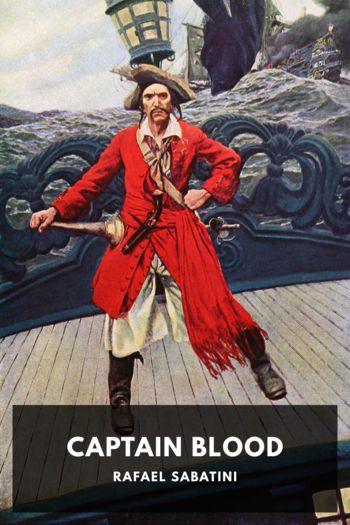Blood and Oranges, James Goldsborough [spicy books to read txt] 📗

- Author: James Goldsborough
Book online «Blood and Oranges, James Goldsborough [spicy books to read txt] 📗». Author James Goldsborough
Preparing for the trial, she refused to yield an inch. Yes, her husband must be punished for Willie Mull’s murder, but he must also pay for what he’d done to her. To ignore that, she told Federmeister, who Pitts sent again to “talk sense” to her, was to treat women as second-class citizens. Frustrated, Pitts invited Angie and her lawyer to the hall of justice for a parley.
“We’re on the same side, you know,” he said. “Adding rape to murder and attempted murder will confuse the jury and jeopardize conviction. The man is your husband.”
“Am I to understand that the district attorney condones spousal rape?” she asked.
“What is spousal rape?” he bellowed at her.
Up for re-election the following year, Pitts complained to Judge Anzug, who summoned them all to his chambers. Anzug had had a complete search done. Not only did California have no law against anything called spousal or marital rape, but neither was such a law to be found in US or English Common Law. “However strongly we might feel about it, spousal rape is not a crime. Plus the fact that it makes people uncomfortable.”
Hilda would have gasped.
“Uncomfortable?” Angie began.
Pitts cut her off. “I agree with Judge Anzug. Attempted murder, yes. Rape, no.”
“Rape may be uncomfortable to the court and to the district attorney . . .”
“Irrelevant, is what I meant,” sputtered the judge. “Rape is irrelevant to this trial.”
“But it is not irrelevant to me,” she said, “or to the thousands of women raped and abused by husbands and frightened out of bringing charges by cowardly courts and district attorneys. Either you allow the rape charges to go forward or I will take it to the newspapers and have it tried in the court of public opinion. Let me ask you both this—what do you think the nation will think of court officers who refuse to prosecute the man who abandoned his wife, then returned and raped and tried to murder her? Do you want me to lift my skirts in court, show the jury the scars that are still there? Is that what you want?”
At home that night, Hilda, who had a good legal mind (better than her husband, some said), suggested a solution. It was not a particularly good solution, but would have to do.
♦ ♦ ♦
November of 1940 was unusually harsh for Los Angeles, and the people who waited in line the night before the trial were cold and miserable, though not enough to give up their places. Local newspapers planned extra street editions throughout the trial. Editorials, never losing sight of their owners’ primary goal, which is to make money, watched closely to see how the wind was blowing. Defenders of tradition, they could not afford to offend the mainstream churches that despised Willie Mull’s evangelism and recoiled at the idea of anointing an adulteress as his successor. But neither could they ignore the “message of Wrigley Field” nor the feminist wave washing across the country since Amelia Earhart took her place beside Eleanor Roosevelt as the world’s most acclaimed champion of women’s rights. Earhart was gone but not the cause she championed, a cause in search of a new torchbearer.
There are seventeen courtrooms scattered over the fourteen floors of the Los Angeles Hall of Justice, and for the State of California vs. Gil l’Amoureux the largest was chosen, seating two hundred people. That left thousands of clamoring, mostly angry women in and around the streets, steps, lobbies, corridors, and elevators who would have to stand in line another night if they wanted to see anything. It took half an hour to get the lucky two hundred into the courtroom, seated and quieted. The Hall of Justice is a massive, classic, Beaux-Arts building whose exterior is constructed primarily of marble and granite. It is stately, solid and normally quiet as any office building except for the top two floors, where the jails are housed. Yet even in his chambers many floors and corridors from the courtroom, Judge Herman Anzug could not escape the din.
Evidence on murder and attempted murder was heard first. Anzug’s initial instinct had been to exclude all testimony on spousal rape, but Sister Angie’s threat to try her case in the newspapers and make a mockery of his trial presented him with a dilemma: He could not try a man for a crime that did not legally exist yet could not deny that the woman had been violently, sexually assaulted, brutalized far outside any acceptable definition of matrimony. Happily, Hilda had shown him the way out.
The defendant’s lawyer was a shifty veteran public defender named Albie Goodman, known to many Hall of Justice denizens, but not to Judge Anzug. Judges have their reputations and rankings, and Anzug, unlike Goodman, was at the top, never assigned to the kind of divorce, bunko, hustle, traffic trials where Goodman made his living. In the five miles of Hall of Justice corridors, never once had their paths crossed. Goodman was as surprised to find himself at the center of a national murder trial as Anzug was to find him in his courtroom. Along with District Attorney Pitts, the judge summoned the defense attorney to his chambers early the first morning to inform them of part of what he (and Hilda) had decided.
“After we empanel, we will hear the murder and attempted murder charges. When that phase is completed, we will hear the plea for spousal rape brought by the plaintiff. I do not expect the second phase to last long, but I’ve decided it’s better to hear what the plaintiff has to say inside the courtroom than outside. Any questions?” Pitts could not move the judge to change his mind. Goodman said nothing. He’d waited for something like this all his legal life.
Empaneling took a full day. Pitts wanted women, and Goodman men, and that it ended up six to six was no surprise. The





Comments (0)